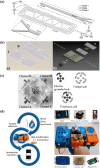Quartz crystal microbalance-based biosensors as rapid diagnostic devices for infectious diseases
- PMID: 32889395
- PMCID: PMC7443316
- DOI: 10.1016/j.bios.2020.112513
Quartz crystal microbalance-based biosensors as rapid diagnostic devices for infectious diseases
Abstract
Infectious diseases are the ever-present threats to public health and the global economy. Accurate and timely diagnosis is crucial to impede the progression of a disease and break the chain of transmission. Conventional diagnostic techniques are typically time-consuming and costly, making them inefficient for early diagnosis of infections and inconvenient for use at the point of care. Developments of sensitive, rapid, and affordable diagnostic methods are necessary to improve the clinical management of infectious diseases. Quartz crystal microbalance (QCM) systems have emerged as a robust biosensing platform due to their label-free mechanism, which allows the detection and quantification of a wide range of biomolecules. The high sensitivity and short detection time offered by QCM-based biosensors are attractive for the early detection of infections and the routine monitoring of disease progression. Herein, the strategies employed in QCM-based biosensors for the detection of infectious diseases are extensively reviewed, with a focus on prevalent diseases for which improved diagnostic techniques are in high demand. The challenges to the clinical application of QCM-based biosensors are highlighted, along with an outline of the future scope of research in QCM-based diagnostics.
Keywords: Biosensor; Diagnosis; Infectious disease; Influenza; Quartz crystal microbalance; Virus.
Copyright © 2020 Elsevier B.V. All rights reserved.
Conflict of interest statement
The authors declare that they have no known competing financial interests or personal relationships that could have appeared to influence the work reported in this paper.
Figures








References
-
- Afzal A., Mujahid A., Schirhagl R., Bajwa S.Z., Latif U., Feroz S. Chemosensors. 2017;5:7.
-
- Allain J.-P., Opare-Sem O. Nat. Rev. Gastroenterol. Hepatol. 2016;13:643–653. - PubMed
-
- Ballantine D.S., Jr., White R.M., Martin S.J., Ricco A.J., Zellers E.T., Frye G.C., Wohltjen H. Elsevier; 1996. Acoustic Wave Sensors: Theory, Design and Physico-Chemical Applications.
-
- Bianco M., Aloisi A., Arima V., Capello M., Ferri-Borgogno S., Novelli F., Leporatti S., Rinaldi R. Biosens. Bioelectron. 2013;42:646–652. - PubMed
Publication types
MeSH terms
LinkOut - more resources
Full Text Sources
Other Literature Sources
Medical

